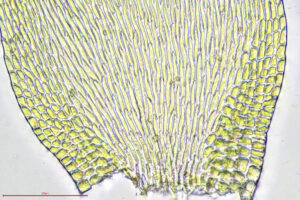Identification notes
Look for this pleurocarp in mature deciduous woodland where there are logs on the ground in shade. Many of these will have a carpet of Hypnum cupressiforme, perhaps with mature capsules. Occasionally you might notice that the capsules on the Hypnum growing on the side of the log are particularly abundant, really bristling out. Time to get out the hand lens. First look at the capsule shape and the lid. Is the capsule just a little bit too long and curved for H. cupressiforme? And that lid – is it a simple cone shape, without a long beak?

Herzogiella seligeri capsules

Hypnum cupressiforme capsules
Now the leaves – widely spaced on the stem and separated from each other so that you can see that the base is inserted on the stem at a right angle, giving a more spikey look to the shoots? This sounds like Herzogiella seligeri and should be taken back to the microscope. If correct, you will see that the leaf is nerveless or with a short double nerve like Hypnum. However the alar cells are not a dense dark green clump of small cells like in Hypnum and don’t really stand out much from the cells above. The leaf margin is denticulate from base to apex unlike in Hypnum which is entire below.

Herzogiella seligeri leaf base

Leaf base. Note distinct but not inflated alar cells.
A final point: H. cupressiforme develops capsules in late summer through to winter (usually) and they are nearly always over by the time Herzogiella gets going in late winter through to summer, so the state of the capsules and the season can help you out. A nice find, often overlooked.
Read the Field Guide account











